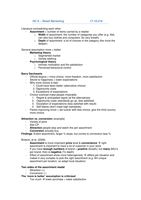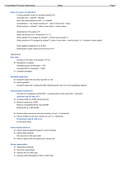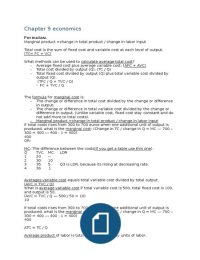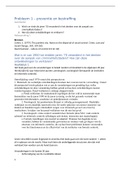Pharmacokinetics lectures
Chapter 1: Therapeutic Relevance & Chapter 2: Fundamental Concepts and
Terminology
Pharmacology is a mixture of Pharmacokinetics and Pharmacodynamics. Regarding pharmacokinetics
the main principle is what is the body doing to the drug. When looking at Pharmacodynamics the
main principle is what is the drug doing to the body.
Pharmacokinetics is found in
practice in the community
pharmacy, the hospital
pharmacy and during drug
development. The goal of
pharmacology is to get the right
drug in the right dose to the
right patient at the right time.
The study of the fate of a drug
in the body in time is observed
with pharmacokinetics, this
involves various processes. These processes can be shortened to ADME. A stands for absorption; how
will the drug get into the body. D stands for distribution; where will the drug be distributed when it is
inside of the body. M stands for metabolism; how is the drug broken down in the body. E stands for
excretion; how does the drug leave the body. Elimination is the metabolism and the excretion
combined. Disposition is the distribution and the elimination together.
For the administration of the drug several routes can be used. It can be intravascularly administrated,
this means that it will go directly into the blood stream, this is done via intravenous injection or
infusion or can be done intra-arterially. With extravascular administration it will not be in the
bloodstream immediately, absorption is needed for this. Drugs can be administered parenterally,
these are all non-oral routes. These oral routes like oral, rectal, sublingual and buccal are categorised
as enteral routes. Local/regional administration is administering the drug close to the place where it
needs to act. When systemic administration is done the drug is administered so that it can affect the
whole body.
The enterohepatic cycle is the circulation of drugs (or other substances) from the liver to the bile,
followed by its entry into the small intestine, absorption by the enterocyte and transport back to the
liver. The first pass effect is the phenomenon of drug metabolism where the concentration of a drug
is greatly reduced before it reaches the systemic circulation, leading to a decrease in bioavailability
(the fraction of administered drug that reaches the systemic circulation).
In the elimination process of the drug excretion and
metabolism are the main determining factors. These factors are
mostly represented by the organs; kidney and liver. Metabolites
are formed by the body, these are compounds that are formed
from the drug usually due to enzymatic reactions (cytochrome
P450 enzymes). These metabolites can either be active or
inactive, this could possibly cause an implication for
pharmacokinetics.
A plasma concentration-time curve is the graph that can be used to look at the absorption,
distribution and the elimination of a drug in the body. In order for a drug to function properly it
, should operate
in the
therapeutic
window, this
window is the
plasma drug
concentration of
a drug in which
the drug can successfully operate. Such a window can be narrow or can be wide, when this is known
the dosing can be adjusted to this. Blood contains plasma and cells such as red blood cells, white
blood cells and platelets. This is approximately 5 to 6 L. Plasma consists for about 90% out of water
and ions, lipids and plasma proteins. This is approximately 3 L that contains no cells. Serum is plasma,
including plasma proteins, but without the clotting factors like fibrinogen and fibrin. To determine
the effect of a drug in a human the development of appropriate models to describe observations and
predict outcomes in other situations is
essential. Such models can either be
equations, physiologic models or
compartmental models. It should be taken
into account that the drug response in people
is different, not everybody reacts the same to
a drug. Also adherence is a major source of
variability in drug therapy, this is mostly due
to the discontinuation of treatment or
because of the poor execution of dosing
regimen.
Chapter 3: Kinetics following an intravenous bolus dose
Intravenous bolus dose is an administration of drug
intravenously, bolus means that the injection is
quick, it enters the systemic circulation
immediately. It can be controlled easily because
nothing is lost during the absorption. Therefore
there is no absorption phase. When administering a
drug the drug does not only stay in the blood
plasma but often also interacts with other tissue.
The volume of distribution is not an actual volume
but it is the calculated volume in which the drug has
spread over the body, it can however be larger than a full human. It can not be smaller than the
plasma volume (4 L). When converting a plasma versus time curve and the plasma axis is made into a
log scale, the graph may become a straight line. When this is the case we can speak of first-order
elimination, this means that
the loss of drug is
proportional to the amount
of drug. This elimination can
be described mathematically
by the formula. The amount
of drug can be converted
into concentration when
Chapter 1: Therapeutic Relevance & Chapter 2: Fundamental Concepts and
Terminology
Pharmacology is a mixture of Pharmacokinetics and Pharmacodynamics. Regarding pharmacokinetics
the main principle is what is the body doing to the drug. When looking at Pharmacodynamics the
main principle is what is the drug doing to the body.
Pharmacokinetics is found in
practice in the community
pharmacy, the hospital
pharmacy and during drug
development. The goal of
pharmacology is to get the right
drug in the right dose to the
right patient at the right time.
The study of the fate of a drug
in the body in time is observed
with pharmacokinetics, this
involves various processes. These processes can be shortened to ADME. A stands for absorption; how
will the drug get into the body. D stands for distribution; where will the drug be distributed when it is
inside of the body. M stands for metabolism; how is the drug broken down in the body. E stands for
excretion; how does the drug leave the body. Elimination is the metabolism and the excretion
combined. Disposition is the distribution and the elimination together.
For the administration of the drug several routes can be used. It can be intravascularly administrated,
this means that it will go directly into the blood stream, this is done via intravenous injection or
infusion or can be done intra-arterially. With extravascular administration it will not be in the
bloodstream immediately, absorption is needed for this. Drugs can be administered parenterally,
these are all non-oral routes. These oral routes like oral, rectal, sublingual and buccal are categorised
as enteral routes. Local/regional administration is administering the drug close to the place where it
needs to act. When systemic administration is done the drug is administered so that it can affect the
whole body.
The enterohepatic cycle is the circulation of drugs (or other substances) from the liver to the bile,
followed by its entry into the small intestine, absorption by the enterocyte and transport back to the
liver. The first pass effect is the phenomenon of drug metabolism where the concentration of a drug
is greatly reduced before it reaches the systemic circulation, leading to a decrease in bioavailability
(the fraction of administered drug that reaches the systemic circulation).
In the elimination process of the drug excretion and
metabolism are the main determining factors. These factors are
mostly represented by the organs; kidney and liver. Metabolites
are formed by the body, these are compounds that are formed
from the drug usually due to enzymatic reactions (cytochrome
P450 enzymes). These metabolites can either be active or
inactive, this could possibly cause an implication for
pharmacokinetics.
A plasma concentration-time curve is the graph that can be used to look at the absorption,
distribution and the elimination of a drug in the body. In order for a drug to function properly it
, should operate
in the
therapeutic
window, this
window is the
plasma drug
concentration of
a drug in which
the drug can successfully operate. Such a window can be narrow or can be wide, when this is known
the dosing can be adjusted to this. Blood contains plasma and cells such as red blood cells, white
blood cells and platelets. This is approximately 5 to 6 L. Plasma consists for about 90% out of water
and ions, lipids and plasma proteins. This is approximately 3 L that contains no cells. Serum is plasma,
including plasma proteins, but without the clotting factors like fibrinogen and fibrin. To determine
the effect of a drug in a human the development of appropriate models to describe observations and
predict outcomes in other situations is
essential. Such models can either be
equations, physiologic models or
compartmental models. It should be taken
into account that the drug response in people
is different, not everybody reacts the same to
a drug. Also adherence is a major source of
variability in drug therapy, this is mostly due
to the discontinuation of treatment or
because of the poor execution of dosing
regimen.
Chapter 3: Kinetics following an intravenous bolus dose
Intravenous bolus dose is an administration of drug
intravenously, bolus means that the injection is
quick, it enters the systemic circulation
immediately. It can be controlled easily because
nothing is lost during the absorption. Therefore
there is no absorption phase. When administering a
drug the drug does not only stay in the blood
plasma but often also interacts with other tissue.
The volume of distribution is not an actual volume
but it is the calculated volume in which the drug has
spread over the body, it can however be larger than a full human. It can not be smaller than the
plasma volume (4 L). When converting a plasma versus time curve and the plasma axis is made into a
log scale, the graph may become a straight line. When this is the case we can speak of first-order
elimination, this means that
the loss of drug is
proportional to the amount
of drug. This elimination can
be described mathematically
by the formula. The amount
of drug can be converted
into concentration when










